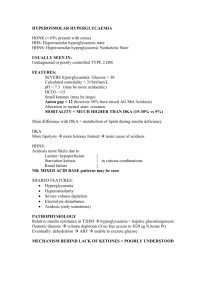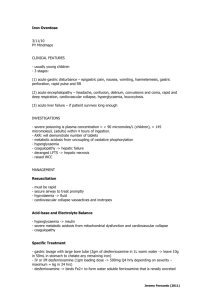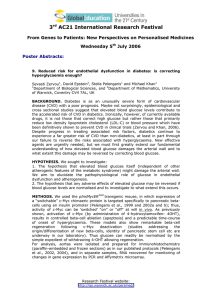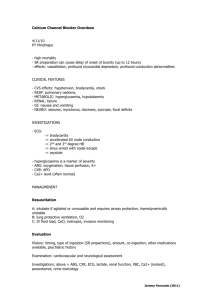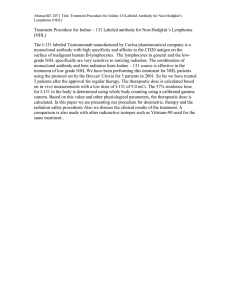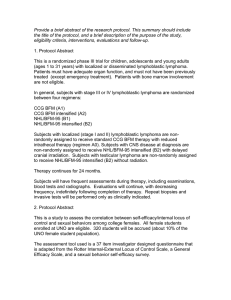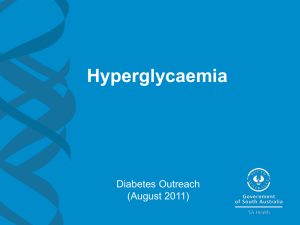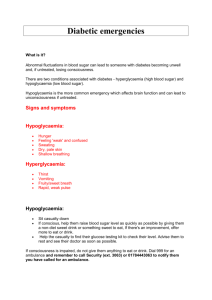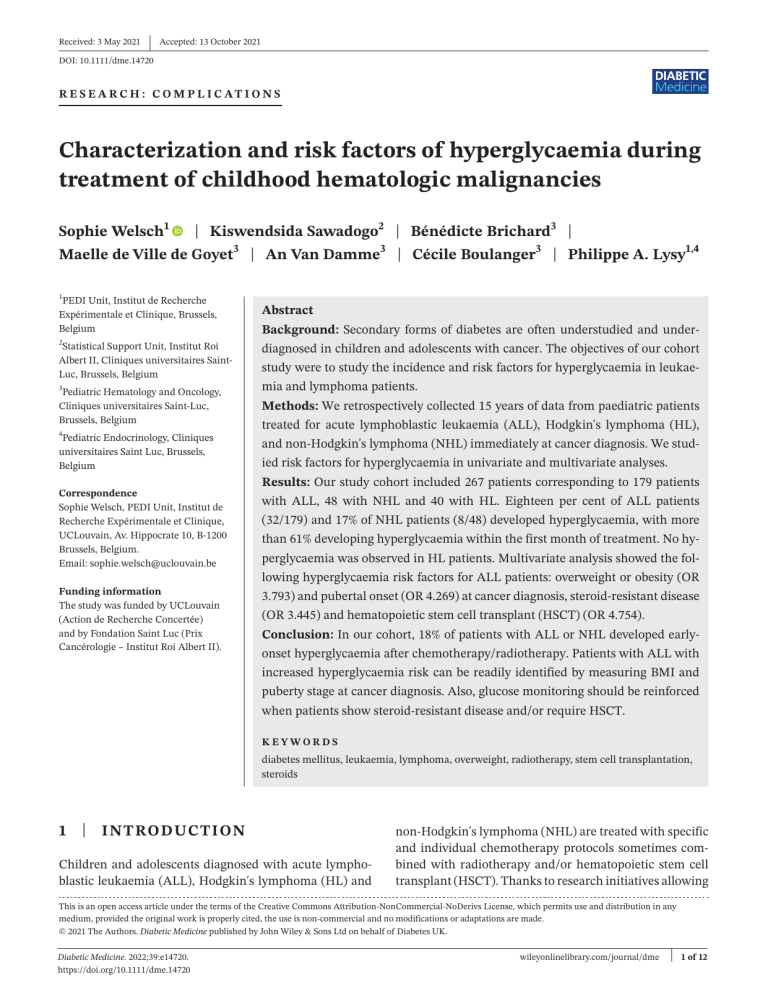
Received: 3 May 2021 | Accepted: 13 October 2021 DOI: 10.1111/dme.14720 R E S E A RC H : C O M P L I C AT I O N S Characterization and risk factors of hyperglycaemia during treatment of childhood hematologic malignancies Sophie Welsch1 | Kiswendsida Sawadogo2 Maelle de Ville de Goyet3 | An Van Damme3 1 PEDI Unit, Institut de Recherche Expérimentale et Clinique, Brussels, Belgium 2 Statistical Support Unit, Institut Roi Albert II, Cliniques universitaires Saint-­ Luc, Brussels, Belgium 3 Pediatric Hematology and Oncology, Cliniques universitaires Saint-­Luc, Brussels, Belgium 4 Pediatric Endocrinology, Cliniques universitaires Saint Luc, Brussels, Belgium Correspondence Sophie Welsch, PEDI Unit, Institut de Recherche Expérimentale et Clinique, UCLouvain, Av. Hippocrate 10, B-­1200 Brussels, Belgium. Email: sophie.welsch@uclouvain.be Funding information The study was funded by UCLouvain (Action de Recherche Concertée) and by Fondation Saint Luc (Prix Cancérologie –­ Institut Roi Albert II). | | Bénédicte Brichard3 | Cécile Boulanger3 | Philippe A. Lysy1,4 Abstract Background: Secondary forms of diabetes are often understudied and underdiagnosed in children and adolescents with cancer. The objectives of our cohort study were to study the incidence and risk factors for hyperglycaemia in leukaemia and lymphoma patients. Methods: We retrospectively collected 15 years of data from paediatric patients treated for acute lymphoblastic leukaemia (ALL), Hodgkin's lymphoma (HL), and non-­Hodgkin's lymphoma (NHL) immediately at cancer diagnosis. We studied risk factors for hyperglycaemia in univariate and multivariate analyses. Results: Our study cohort included 267 patients corresponding to 179 patients with ALL, 48 with NHL and 40 with HL. Eighteen per cent of ALL patients (32/179) and 17% of NHL patients (8/48) developed hyperglycaemia, with more than 61% developing hyperglycaemia within the first month of treatment. No hyperglycaemia was observed in HL patients. Multivariate analysis showed the following hyperglycaemia risk factors for ALL patients: overweight or obesity (OR 3.793) and pubertal onset (OR 4.269) at cancer diagnosis, steroid-­resistant disease (OR 3.445) and hematopoietic stem cell transplant (HSCT) (OR 4.754). Conclusion: In our cohort, 18% of patients with ALL or NHL developed early-­ onset hyperglycaemia after chemotherapy/radiotherapy. Patients with ALL with increased hyperglycaemia risk can be readily identified by measuring BMI and puberty stage at cancer diagnosis. Also, glucose monitoring should be reinforced when patients show steroid-­resistant disease and/or require HSCT. KEYWORDS diabetes mellitus, leukaemia, lymphoma, overweight, radiotherapy, stem cell transplantation, steroids 1 | I N T RO DU CT ION Children and adolescents diagnosed with acute lymphoblastic leukaemia (ALL), Hodgkin's lymphoma (HL) and non-­Hodgkin's lymphoma (NHL) are treated with specific and individual chemotherapy protocols sometimes combined with radiotherapy and/or hematopoietic stem cell transplant (HSCT). Thanks to research initiatives allowing This is an open access article under the terms of the Creative Commons Attribution-­NonCommercial-­NoDerivs License, which permits use and distribution in any medium, provided the original work is properly cited, the use is non-­commercial and no modifications or adaptations are made. © 2021 The Authors. Diabetic Medicine published by John Wiley & Sons Ltd on behalf of Diabetes UK. Diabetic Medicine. 2022;39:e14720. https://doi.org/10.1111/dme.14720 wileyonlinelibrary.com/journal/dme | 1 of 12 2 of 12 | constant re-­evaluation of these protocols, the survival rate of childhood cancer exceed 83%.1 However, the effectiveness of these treatments is not without consequences: 50% of childhood cancer survivors (CCS) develop endocrine sequelae including metabolic syndrome and glucose metabolism disorders such as diabetes, insulin resistance and impaired glucose tolerance (IGT).2–­4 In the general population, diabetes confers two to three times increased risk of cardiovascular disease and corresponds to 12%–­55% of cases of end-­stage renal disease worldwide,5 being as such the 7th expected leading cause of death by 2030.6 In CCS, the incidence of hyperglycaemia is still ill-­ defined and might range between 11% and 35% of cases.7–­13 Moreover, despite the whole body of evidence that asparaginase,12 steroids14 and total body irradiation15 increase the risk of developing hyperglycaemia and diabetes, risk factors are missing and –­ asides from treatments –­ understudied (e.g., pre-­existing obesity, sex, age, ethnicity, family history of diabetes, etc.). The purpose of our study was to assess the incidence and associated risk factors of developing hyperglycaemia in children and adolescents diagnosed with ALL, HL and NHL. Deciphering the factors associated with the onset of hyperglycaemia in paediatric patients treated for cancer will provide leverage for lifestyle or therapeutic intervention from a prevention perspective in newly diagnosed patients. 2 2.1 | M AT E R IALS AN D M ET H OD S | Study design The DIABONCO retrospective study is being carried out in collaboration with the Paediatric Haematology and Oncology (Institut Roi Albert II) of Cliniques universitaires Saint-­Luc in Belgium (Brussels). Our investigations included patients receiving treatment protocols conferring a diabetogenic risk. These included the total body, cranial, and abdominal irradiation (respectively TBI, CI, and AI), steroids and L-­asparaginase. Our cohort was, therefore, composed of patients treated for acute lymphoblastic leukaemia (ALL), Hodgkin's lymphoma (HL) and non-­Hodgkin's lymphoma (NHL). The local ethical committee (Saint-­Luc and UCL Hospital-­Faculty Ethics Committee) approved this study protocol (approval number 2018/20MAR/122) and the study was conducted in accordance with the Declaration of Helsinki. 2.2 | WELSCH et al. Inclusion and exclusion criteria We included all children and adolescents aged 0 to 18 years treated with the aforementioned diabetogenic Novelty statement • It is well known that hyperglycaemia in childhood cancer is caused by the use of steroids, asparaginase and total body irradiation. • Two new risk factors of hyperglycaemia were identified in paediatric patients with acute lymphoblastic leukaemia: puberty and steroid-­ resistant disease. • This work will help clinicians to identify patients with acute lymphoblastic leukaemia at risk of early onset of hyperglycaemia, by considering BMI and pubertal stage as potential markers and by monitoring blood glucose levels closely during treatment intensification for steroid-­resistant disease or relapse, especially when total body irradiation and stem cell transplantation are required. treatment protocols and diagnosed at Cliniques universitaires Saint-­Luc with ALL, NHL or HL between January 2004 and December 2019. We excluded patients with an incomplete file or a history of the following conditions: previous diabetes (i.e. type 1, type 2, neonatal or monogenic diabetes), pancreatitis, steatosis, Down syndrome, pancreas and liver surgery, kidney disease and previous cancer other than leukaemia and lymphoma. The patients were stratified according to the presence or absence of hyperglycaemia during the treatment protocol and during clinical follow-­up, which ended in August 2020. The groups were called the "hyperglycaemia-­positive ALL, NHL or HL" and the “hyperglycaemia-­free ALL, NHL or HL". 2.3 | Treatments protocols In Belgium, ALL, HL and NHL paediatric patients are treated with chemotherapy and radiotherapy according to international guidelines. Several protocols were used for the three pathologies depending on the treatment era, the severity of the disease, the age of patients and the response to treatment. Despite some differences in protocols in the same cohort, the treatment pattern remains unchanged. For ALL patients, the theoretical treatment lasts at least two years and begins with pre-­phase with the introduction during seven days of steroids and followed by induction with 21 days of steroids, consolidation, interval, re-­induction with also 21 days of steroids and finishes with maintenance phase, which sometimes includes steroids (Table S1 and Figure S1). Treatments for NHL and HL are much shorter WELSCH et al. than ALL treatment and last a maximum of six months. If an ALL patient presents steroid-­resistance disease at the end of the pre-­phase, the protocol will be intensified with an extended consolidation phase with longer doses of steroids and L-­asparaginase. When ALL patient presents a relapse during treatment or abnormal cytogenetics, HSCT may be considered, some of them with TBI. 2.4 | Diagnosis of hyperglycaemia According to guidelines of the international consensus for diabetes of the American Diabetes Association (ADA), we considered that patients developed hyperglycaemia when random capillary blood or plasma glucose levels exceeded 11 mmol/L (200 mg/dl), for at least two measurements separated by 24 h. Hyperglycaemia was identified based on glycaemic measurements during treatment protocols and clinical follow-­up. Inpatients are subjected to daily blood analyses, which periodically include the measurement of plasma glucose levels. When hyperglycaemia occurs, the theoretical protocol implemented in clinics requires the confirmation of this hyperglycaemia by plasma glucose measurement and capillary glucose monitoring until resolution of hyperglycaemia. 2.5 | Variables of interests For all patients, the following data were collected and managed using REDCap (Research Electronic Data Capture) tools16,17 provided by the Vanderbilt University (Nashville, USA) and hosted at Cliniques universitaires Saint-­Luc. We collected personal patient data such as sex, date of birth, country of origin, weight, height and gestation at birth, complications during pregnancy (pre-­ or post-­term, events, foetal macrosomia), dysmaturity, hypoglycaemia and hyperglycaemia in the neonatal period, the presence or absence of previous overweight (BMI >85th centile)/obesity (BMI >95th centile),18 endocrine disease, autoimmune disease, acanthosis nigricans, sickle cell anaemia, any chronic treatment, date of death if the patient died. Regarding the patient's family history, we registered the presence or absence of previous gestational diabetes, polycystic ovarian syndrome, infertility, dystocia, consanguinity, diabetes, metabolic syndrome, sickle cell anaemia, pancreatic or liver surgery. We also gathered information about the primary diagnosis and its treatment: type of cancer, diagnosis date, stage and localization of the tumour, anthropometric data on diagnosis, tanner stage, blood pressure (systolic and | 3 of 12 diastolic), treatments protocols (presence or absence of steroids, asparaginase, radiotherapy and HSCT) and the presence of treatment side effects such as steroid-­resistant disease, allergy to asparaginase, pancreatitis and steatosis induced by treatment protocol. When the patient developed hyperglycaemia more than twice, we reported the date, the anthropometric data of onset, the blood pressure, the treatment for the hyperglycaemia (e.g. insulin therapy, metformin), its doses per day and its duration. To obtain the number of blood glucose levels recorded, we counted all blood glucose measurements from the start of treatment protocol until the end of our study (August 2020). The duration of blood glucose monitoring was evaluated by counting blood glucose measurements performed without an interruption of more than 6 months and deceased patients were excluded. To evaluate the percentage of patients having been tested for blood glucose after the maintenance phase, we included only ALL patients treated before 2015 and HL patients treated before 2017 to have a sufficient delay between the end of the maintenance phase and the end of our study for the metabolic outcome monitoring. Standard deviation score (SDS) for height, weight and BMI were assessed using, respectively, Belgian Flemish reference charts and Cole's Corpulence Curve.19,20 2.6 | Statistical analysis Descriptive statistics were used to summarize the results considering numbers and percentages for discrete variables, means with standard deviations (SD) and medians with interquartile range (IQR) for continuous variables. The clinical characteristics of patients were compared according to the occurrence or not of hyperglycaemia using Student's t test or Mann–­Whitney test (as appropriate) for continuous variables and Fisher exact test for discrete variables. Kaplan-­Meier estimates of the probability of remaining free of hyperglycaemia were plotted. A binary logistic regression analysis was performed to predict hyperglycaemia occurrence from all potential predictors available by estimating odds ratios and their 95% confidence intervals. All covariates with a p-­value less than 0.10 in univariate analysis were introduced into a multivariate model (Wald Chi-­Square). Variance inflation factor analysis was performed to detect a potential multicollinearity problem. A backward elimination strategy was used to estimate the best prediction model. Analyses were performed using SAS V9.4 software (SAS Institute Inc.). All p-­values were two-­sided and values less than 0.05 was considered statistically significant. 4 of 12 | WELSCH et al. ALL, NHL and LH treated in CUSL from 2004 to 2019 Three cohorts, n=303 Paents excluded - Incomplete file (nALL =5; nNHL=2; nHL=2) - Previous transplantaon of liver (nNHL=8), kidney (nNHL=2) or cardiac (nNHL=1) - Cancer other than leukaemia and lymphoma (nALL=2; nNHL=5) - Tumour removal with no chemotherapy (nNHL=2) - Death soon aer cancer diagnosis (nALL=5) - Down syndrome (nALL=2) n=36 (12%) Acute lymphoblasc Leukaemia n=179 (67%) Non-Hodgkin Lymphoma n=48 (18%) Hodgkin Lymphoma n=40 (15%) F I G U R E 1 Flow chart of the study. Out of 303 patients treated in the Cliniques Universitaires Saint Luc (CUSL) from January 2004 and December 2019, 179 (67%) patients were diagnosed with Acute lymphoblastic leukaemia (ALL), 48 (18%) with non-­Hodgkin lymphoma (NHL) and 40 (15%) with Hodgkin lymphoma (HL). n, number of patients 3 3.1 | R E S U LTS | Patient characteristics We included 267 children and adolescents out of 303 patients (Figure 1) treated in the Cliniques universitaires Saint-­Luc from January 2004 and December 2019, divided as such: 179 (67.0%) patients were diagnosed with ALL, 48 (18.0%) with NHL and 40 (15.0%) with HL. We excluded 36 patients because of an incomplete file (nALL = 5; nNHL = 2; nHL = 2), down syndrome (nALL = 2), death soon after cancer diagnosis (nALL = 5), tumour removal with no chemotherapy (nNHL = 2), previous transplantation of liver (nNHL = 8), kidney (nNHL = 2) or cardiac (nNHL = 1) and cancer other than leukaemia and lymphoma (nALL = 2; nNHL = 5). Clinical characteristics of the three cohorts are summarized in Table 1. 3.2 | Treatments characteristics Treatment characteristics are presented in Table 2. The median duration of cancer treatment was 32.9 (25.6; 33.7) months for ALL patients, 3.5 (2.6; 13.1) months and 3.8 (2.8; 6.2) months for NHL and HL patients, respectively. All three cohorts received steroids whereas asparaginase was prescribed to ALL (100.0%) and NHL cohorts (33.3%) but not to HL patients. The proportion of patients receiving radiotherapy was 9.5%, 6.3% and 37.5% in the ALL, NHL and HL cohorts. Patients from the ALL cohort required cranial (64.7%) and total body (41.2%) radiotherapy, while HL patients received abdominal (66.7%) and cervical (33.3%) irradiation. Of the three irradiated patients of the NHL cohort, each received radiation at a different site (AI, CI, TBI). The frequency of patients requiring HSCT was 9.5% (17/179), 10.4% (5/48) and 7.5% (3/40) for the ALL, NHL and HL cohorts, respectively. 3.3 | Incidence and evolution of hyperglycaemia during the treatment Of the 267 children and adolescents, 17.9% (32/179) of the ALL patients and 16.7% (8/48) of NHL patients developed hyperglycaemia (Table 3). No hyperglycaemia was observed in the HL cohort. Hyperglycaemia developed rapidly after initiation of chemotherapy protocols: approximatively 61.0% (19/32) of ALL patients and all NHL patients except one (7/8) developed hyperglycaemia within the first month of treatment, corresponding to pre-­ and induction phases (Figure 2). The median number of blood glucose measurements recorded per patient was 24 (19; 36) for ALL patients, 26 (18; 40) for NHL patients, and 5 (3; 7) for HL patients (Table 3). The median duration of follow-­up of blood glucose levels recorded during treatment protocols was 8.6 months (6.2; 12.7) and 3.6 months (2.4; 6.1) for ALL and NHL patients, respectively, and covered the four first phases of cancer WELSCH et al. TABLE 1 | 5 of 12 Patients characteristics Acute lymphoblastic leukaemia Non-­Hodgkin lymphoma Hodgkin lymphoma N 179 48 40 Age at cancer diagnosis, median (P25–­P75) 4.8 (3.1; 10.8) 9.7 (7.1; 13.8) 13.2 (10.4; 15.5) [0–­8] years [n (%)] 120 (67.0) 16 (33.3) 6 (15.0) [9–­18] years [n (%)] 59 (33.0) 32 (66.7) 34 (85.0) Gender, male [n (%)] 107 (59.8) 34 (70.8) 29 (72.5) Weight SDS, median (P25–­P75) −0.1 (−0.8; 0.5) −0.2 (−0.8; 0.8) −0.1 (−0.7; 0.5) Height SDS, median (P25–­P75) 0.1 (−0.5; 0.6) 0.0 (−0.3; 0.5) −0.2 (−0.7; 0.5) Body Mass Index SDS, median (P25–­P75) −0.3 (−1; 0.6) −0.4 (−1.1; 1.1) 0.0 (−0.8; 0.8) Tanner staging P < 2 [n (%)] 138 (77.1) 28 (58.3) 16 (40.0) Tanner staging M/G < 2 [n (%)] 138 (77.1) 27 (56.2) 17 (42.5) Death [n (%)] 17 (9.5) 5 (10.4) 0 (0.0) Abbreviations: G, genital; M, mammary; P, pubic; SDS, standard deviation score. TABLE 2 Treatments characteristics Acute lymphoblastic leukaemia Non-­Hodgkin lymphoma Hodgkin lymphoma N 179 48 40 Duration of cancer treatment, month, median (P25; P75) 32.9 (25.6; 33.7) 3.5 (2.6; 13.1) 3.8 (2.8; 6.2) Cancer treatment lower risk [n (%)] 151 (84.4) 38 (79.2) 40 (100.0) Cancer treatment higher risk [n (%)] 28 (15.6) 10 (20.8) —­ Treatment with steroids [n (%)] 179 (100.0) 48 (100.0) 40 (100.0) Treatment with asparaginase [n (%)] 179 (100.0) 16 (33.3) —­ Treatment with radiotherapy [n (%)] 17 (9.5) 3 (6.3) 15 (37.5) Cranial irradiation [n (%)] 11 (6.1) 1 (2.1) —­ Total body irradiation [n (%)] 7 (3.9) 1 (2.1) —­ Abdominal irradiation, [n (%)] —­ 1 (2.1) 10 (25.0) Cervical irradiation [n (%)] —­ —­ 5 (12.5) Total irradiation doses, Grays, median (P25; P75) 18 (12; 18) 10 (8; 18) 40 (20; 40) Treatment with HSCT [n (%)] 17 (9.5) 5 (10.4) 3 (7.5) Allogenic transplantation [n (%)] 15 (8.4) 2 (4.2) —­ Autologous transplantation [n (%)] 2 (1.1) 3 (6.2) 3 (7.5) 2 (1.1) 1 (2.1) —­ Asparaginase-­induced pancreatitis [n (%)] Abbreviation: HSCT, hematopoietic stem cell transplantation. treatment for ALL patients and all the treatment protocol period for NHL patients (Table 3, Figures S1 and S2). Blood glucose measurements are constantly performed during treatment protocols for ALL and NHL patients, with a peak during the induction phase and a decrease during maintenance and remission phases (Figures S1 and S2). For HL patients, median blood glucose monitoring lasted 4 days (1; 68) and was close to diagnosis (Table 3). The percentage of patients with blood glucose recorded after the maintenance phase for the metabolic outcome monitoring was 77.8% (91/117), 76.7% (33/43) and 88.9% (32/36) for ALL, NHL and HL patients, respectively (Table 3). At 12 months post ALL treatment, the probability of remaining free of hyperglycaemia was 83.8% and remained relatively unchanged thereafter (end in August 2020). In the NHL group, this probability remained unchanged at 85.4% after one month of cancer treatment (Figure 3). Half (16/32) of the hyperglycaemia-­positive ALL cohort and three out of eight hyperglycaemia-­positive NHL patients were treated with insulin and all required insulin therapy 6 of 12 | WELSCH et al. TABLE 3 Incidence of hyperglycaemia Acute lymphoblastic leukaemia Non-­Hodgkin lymphoma Hodgkin lymphoma N 179 48 40 Hyperglycaemia [n (%)] 32 (17.9) 8 (16.7) 0 Insulin treatment [n (%)] 16 (8.9) 3 (6.3) 0 Number of blood glucose levels, median (P25; P75) 24 (19; 36) 26 (18; 40) 5 (3; 7) Na 162 43 40 Duration of blood glucose monitoring, month, median (P25; P75) 8.6 (6.2; 12.7) 3.6 (2.4; 6.1) 0.13 (0.03; 2.2) Nb 117 43 36 Patient with blood glucose recorded after maintenance phase [n (%)] 91 (77.8) 33 (76.7) 32 (88.9) a Due to interrupted follow-­up, deceased patients (n = 17) were excluded. b Dead patients and ALL patients treated after 2015 and HL patients treated after 2017 were excluded. F I G U R E 2 Distribution of hyperglycaemia onset over time in acute lymphoblastic leukaemia (ALL) and non-­Hodgkin lymphoma (NHL) paediatric cohorts. Most of (a) ALL patients (61%) and (b) NHL patients (87%) developed hyperglycaemia within the first month of treatment [Colour figure can be viewed at wileyonlinelibrary.com] only during a treatment protocol, except one ALL patient who remained insulin-­dependent (Table 3). Besides this, only known case from our cohort with persistent diabetes, the median duration of insulin therapy for the 16 patients with ALL and the three patients with NHL was 15 days (3; 30) and 13 days (12;14), respectively. 3.4 | Risk factors for hyperglycaemia In univariate analysis, age older than 8 years and greater BMI SDS were significantly associated with the onset of hyperglycaemia (OR 1.01; p = 0.002 and OR 20.80; p = 0.008, respectively) as shown in Table 4 and illustrated in Figure 4. Median age at cancer diagnosis was 10.8 (3.3; 15.1) years for the hyperglycaemia-­positive ALL cohort and 4.4 (3.0; 8.7) years for the hyperglycaemia-­free ALL cohort and median BMI SDS at cancer diagnosis was 0.2 (−0.8; 1.2) and −0.4 (−1.0; 0.5), respectively (Table 5). Furthermore, the unadjusted odds ratio of hyperglycaemia for a patient over 8 years old was higher (OR 4.62) compared to patients younger than 8 years, and this difference was significant (p < 0.001). Other covariates were also significantly associated with the onset of hyperglycaemia such as a Tanner stage at cancer diagnosis equal to or greater than 2 (OR 4.88; p < 0.001), a positive history of obesity/overweight (OR 4.29; p = 0.008), a steroid-­ resistant disease (OR 3.20; p = 0.014), or HSCT (OR 5.11; p = 0.002). Furthermore, high-­risk treatment was associated with hyperglycaemia development compared to low-­ risk treatment (OR 4.01; p = 0.002) (Table 4). After adjustment in the multivariate analysis, the best model to predict hyperglycaemia occurrence included two individual factors and two factors related to treatment. ALL patients with a history of obesity/overweight (OR 3.793, 95% CI 1.026–­14.022), a pubertal stage equal to or greater than 2 (OR 4.269, 95% CI 1.676–­10.875) at cancer diagnosis, the presence of steroid-­resistant disease (OR 3.445, 95% CI 1.114–­10.657) and the use of HSCT (OR 4.754, 95% CI 1.099–­20.554) were associated with a higher risk of developing hyperglycaemia (Tables 4 and 5). Due to insufficient statistical power, no association between TBI and hyperglycaemia onset could be demonstrated but five out of the eight patients (seven ALL and one NHL) who received TBI, developed hyperglycaemia (Table 5). The same observation applied for asparaginase-­induced WELSCH et al. | 7 of 12 (a) Proportion remaining free of hyperglycaemia F I G U R E 3 Kaplan–­Meier estimates of the probability of remaining free of hyperglycaemia in acute lymphoblastic leukaemia (ALL) and non-­Hodgkin lymphoma (NHL) paediatric cohorts. (a) At 12 months post ALL treatment, the probability of remaining free of hyperglycaemia was 83.8% and remained relatively unchanged thereafter. (b) In the NHL group, this probability remained unchanged at 85.4% after one month of cancer treatment [Colour figure can be viewed at wileyonlinelibrary.com] Probability of remaining free of hyperglycaemia from the beginning of ALL treatment Proportion remaining free of hyperglycaemia (b) Probability of remaining free of hyperglycaemia from the beginning of NHL treatment pancreatitis as a risk factor, since logistic regression was not possible because no patients in the hyperglycaemia-­free ALL cohort developed asparaginase-­induced pancreatitis during cancer treatment. However, all three patients (two ALL and one NHL) who developed asparaginase-­induced pancreatitis, subsequently developed hyperglycaemia (p = 0.031) (Table 5). In contrast, there was no association between cranial irradiation and hyperglycaemia since in a total of eleven ALL patients receiving cranial irradiation, only one developed hyperglycaemia (Table 5). 8 of 12 | WELSCH et al. T A B L E 4 Univariate (Likelihood Ratio) and multivariate (Wald Chi-­Square) logistic regression analyzes of factors leading to hyperglycaemia occurrence for ALL and NHL cohorts Univariate analysis Multivariate analysis Odds ratio (95% CI) Odds ratio (95% CI) ALL predictors N Age at cancer diagnosis 179 0.002 179 <0.001 BMI SDS 179 0.017 1.486 (1.072–­2.059) BMI SDS overweight versus Normal weight 179 0.008 20.800 (2.231–­193.96) Cancer treatment risk higher versus lower 179 0.002 4.006 (1.649–­9.730) History of overweight at cancer diagnosis 179 0.008 4.293 (1.464–­12.588) 0.046 3.793 (1.026–­ 14.022) Tanner staging ≥2 179 <0.001 4.880 (2.159–­11.032) 0.002 4.269 (1.676–­ 10.875) Steroid-­resistant disease 179 0.014 3.204 (1.265–­8.113) 0.032 3.445 (1.114–­ 10.657) HSCT 179 0.002 5.111 (1.795–­14.553) 0.037 4.754 (1.099–­ 20.554) 48 0.038 5.667 (1.104–­29.073) Age: [0–­8] versus [9–­18] p-­value p-­value 1.010 (1.004–­1.017) 4.615 (2.066–­10.312) NHL predictors Cancer treatment risk higher versus lower Abbreviations: ALL, acute lymphoblastic leukaemia; BMI, body mass index; CI, confidence interval; HSCT, hematopoietic stem cell transplantation; NHL, non-­Hodgkin lymphoma; SDS, standard deviation score. F I G U R E 4 (a) Age and (b) BMI as risk factors of hyperglycaemia in acute lymphoblastic leukaemia (ALL) paediatric cohort. ALL patients with older age and higher BMI are more at risk of developing hyperglycaemia. Each point represents a patient. The boxplot represents the median, the minimum and maximum values. Asterisks (*, **) show a significant difference between hyperglycaemia-­ positive ALL and hyperglycaemia-­free ALL cohorts (*p < 0.05 and **p < 0.01; Mann–­Whitney test) [Colour figure can be viewed at wileyonlinelibrary.com] WELSCH et al. TABLE 5 | 9 of 12 Comparison of the clinical characteristics of hyperglycaemia-­positive ALL and hyperglycaemia-­free ALL cohorts Hyperglycaemia-­positive ALL, n = 32 Age at cancer diagnosis, median (P25; P75) [0–­8] [n (%)] [9–­18] [n (%)] BMI SDS, median (P25; P75) History of overweight [n (%)] 10.8 (3.3; 15.1) 13 (40.5) 19 (59.5) 0.2 (−0.8; 1.2) Hyperglycaemia-­free ALL, n = 147 4.4 (3,0; 8.7) 108 (73.5) p-­value 0.016 <0.001 39 (26.5) −0.4 (−1.0; 0.5) 0.017 7 (21.9) 9 (6.1) 16 (50.0) 25 (17.0) <0.001 9 (28.1) 16 (10.9) 0.021 Cancer treatment lower risk [n (%)] 21 (65.6) 130 (88.4) 0.003 Cancer treatment higher risk [n (%)] 11 (34.4) 17 (11.6) Radiotherapy treatment [n (%)] 5 (15.6) 12 (8.2) 0.193 Cranial irradiation [n (%)] 1 (3.1) 10 (6.8) NA Total body irradiation [n (%)] 4 (12.5) 3 (2.0) NA Treatment with HSCT [n (%)] 8 (25) 9 (6.1) 0.003 Asparaginase-­induced pancreatitis [n (%)] 2 (6.3) 0 (0.0) 0.031 Tanner staging ≥2 [n (%)] Steroid-­resistant disease [n (%)] 0.011 Note: Student t test or Mann–­Whitney test for continuous variables and Fisher exact test for discrete variables were used to obtain the p-­values. Abbreviations: ALL, acute lymphoblastic leukaemia; BMI, body mass index; HSCT, hematopoietic stem cell transplantation; SDS, standard deviation score. Due to the low number of NHL patients and hyperglycaemia-­positive NHL patients, the univariate analysis only allowed us to identify that high-­risk treatment was significantly associated with hyperglycaemia onset compared to low-­risk treatment in the NHL cohort (OR 5.67; p = 0.038) (Table 4). There was no difference in the gender, family history of diabetes or metabolic syndrome, type T or B cancer (nature of the disease), type of transplant and between the anthropometric data reported at cancer and hyperglycaemia diagnosis (weight, height, BMI). 4 | DI S C USSION Our study describes the incidence and risk factors of hyperglycaemia onset, immediately at treatment initiation, in a cohort of paediatric patients treated for ALL, NHL or HL. We showed that 18% of ALL patients and 17% of NHL patients developed hyperglycaemia described as random capillary blood or plasma glucose level exceeding 11 mmol/L (200 mg/dl) for at least two measurements separated by 24 h. The incidence of hyperglycaemia observed in our ALL cohort is similar to a previous study carried out in 2008 by the team of Howard were 16% out of 871 paediatric patients with ALL presented hyperglycaemia during the treatment.8 More recently, three studies described 16.5% (22/133) and 15.7% (16/102 and 57/363) of ALL paediatric patients with hyperglycaemia (in more than two consecutive measurements).9,11,21 The impact of NHL treatment protocols on hyperglycaemia onset is less studied; however, the study by Neville et al. showed in a smaller cohort of 20 NHL patients a high incidence of glycaemic dysregulation: 5 patients (25%) developed either hyperinsulinemia, IGT or diabetes.22 In our study, the majority of ALL (61%) and NHL (87%) patients developed hyperglycaemia within the first month of chemotherapy, corresponding to pre-­ and induction phases that are the most aggressive in terms of steroid doses. Only half of hyperglycaemia-­positive ALL and NHL patients were given insulin therapy and one hyperglycaemia-­positive ALL patient presented persistent non-­type 1 diabetes. Also, we observed that the majority of the three cohorts (ALL: 77.8%, NHL: 76.7% HL: 88.9%) benefited from blood glucose control during monitoring of side effects but this monitoring did not include a dynamic test such as the oral glucose tolerance test. Since all patients treated for leukaemia or lymphoma required steroid treatment but not all developed hyperglycaemia, we sought to identify hyperglycaemia predisposing risk factors in our paediatric cohort. Our multivariate analysis revealed that a history of obesity/overweight at cancer diagnosis is associated with a higher risk of developing hyperglycaemia in ALL patients, as described elsewhere.7,12,13,23 Also similar to other studies presented by Gregoriou in a recent review,24 being older than 10 years (Gregoriou) or 8 years (this paper) was identified as a strong risk factor of hyperglycaemia in our univariate analysis (p < 0.001) but was not an independent risk factor in our multivariate analyses. Associated with the age factor, we identified a strong correlation between pubertal entry (Tanner stage ≥2) and hyperglycaemia risk. In 10 of 12 | normal puberty, rising sex steroid and growth hormone levels are associated with reduced insulin sensitivity, which may predispose to the development of metabolic syndrome in overweight/obese children. Indeed, reduced insulin sensitivity is not uncommon (8%) in extremely obese children.25 The stronger treatment-­related risk factor for hyperglycaemia that emerged from our study is a steroid-­resistant disease for ALL patients. Patients with a steroid-­resistant disease receive a more aggressive and risky treatment protocol and “high-­risk treatment” was associated with hyperglycaemia onset for ALL patients in our univariate analysis (OR 4.01; p = 0.002). Although we do not know if patients received “high risk” treatment due to the more aggressive nature of cancer or because of steroid-­resistant disease. HSCT is also a composite risk factor of hyperglycaemia for ALL patients in our study. Indeed, HSCT is often preceded by TBI and may require the use of steroids in case of graft versus host disease symptoms. Studies carried out on CCS showed that TBI and HSCT together increase the risk of IGT and diabetes.15,22,26 In our study, we also observed that ALL patients who received TBI followed by HSCT tended to develop hyperglycaemia (5/8), though the number of patients with TBI was insufficient to reach significance. Moreover, in our NHL cohort, HSCT did not emerge as a risk factor of hyperglycaemia, yet two out of five patients with HSCT developed hyperglycaemia. L-­asparaginase induces hyperglycaemia as a result of reduced insulin synthesis due to depletion of the available pool of asparagine concurrent with hyperglucagonemia and probably by a reduction of the number of insulin receptors.27 In agreement with the results of the study by Irga et al. describing paediatric patients with ALL, NHL and severe aplastic anaemia, we did not find a correlation between L-­asparaginase treatment and hyperglycaemia onset.28 However, as emphasized in a review paper by Hijiya, L-­asparaginase-­induced pancreatitis is known to affect 2% to 18% of ALL patients and consequently causes the rapid development of diabetes.29 In our study, it is noticeable that all patients who developed pancreatitis induced by L-­asparaginase had subsequently developed hyperglycaemia, although it concerns only three patients. The absence of hyperglycaemia observed in HL patients can be explained by several hypotheses. Potentially less blood glucose monitoring is done linked to their outpatient status, compared to inpatient treatment for ALL and NHL patients. In addition to less blood glucose testing, there is no exposure to potential diabetogenic treatment protocols such as L-­asparaginase and TBI, and there is a discontinuous prescription of steroids with a lower theoretical cumulative monthly dose of steroids for HL patients compared to ALL patients. Also, HL patients WELSCH et al. required abdominal and cervical irradiation, yet we retrieved only TBI as a risk of hyperglycaemia development in our ALL cohort. Abdominal, cervical and cranial radiation did not appear to induce hyperglycaemia in our study, although this is contrary to findings in other studies which suggested the effect of abdominal radiation.30–­32 Strengths of our study include the large sample size of ALL patients, inclusion of risk factors for hyperglycaemia, complete patient records and numerous harmonized blood glucose data for ALL and NHL. Furthermore, we studied the incidence of hyperglycaemia from the initiation of cancer treatment and not only during remission (after 2 years). One major limitation of our study was the inclusion of patients who received different ALL, NHL and HL treatment protocols from different treatment eras. The retrospective nature of the study was a limitation although patient records were mostly complete. Moreover, the availability of blood glucose data varied and decreased in maintenance and remission phases for the three cohorts, preventing a potential diagnosis of persistent diabetes or late diabetes (i.e. irradiation treatment) and was limited for HL patients by the ambulatory follow-­up. In conclusion, in our paediatric study, hyperglycaemia was diagnosed in 18% of ALL patients, 17% of NHL patients but not in HL patients. Puberty and overweight at the time of cancer diagnosis as well as steroid-­resistant disease, HSCT preceded by TBI, and asparaginase-­induced pancreatitis was identified as risk factors for hyperglycaemia in paediatric patients with ALL. We believe our study may help clinicians to identify ALL patients at risk of early onset of hyperglycaemia since our study highlights the importance of considering BMI and pubertal stage as potential markers for the onset of hyperglycaemia in children and adolescents receiving diabetogenic cancer treatments. In addition, our study shows the importance of closely monitoring blood glucose levels during treatment intensification when patients present steroid-­resistant disease or relapse, especially when TBI and HSCT are required. Recognising the reduction of available blood glucose levels in the remission phase and their absence in the Hodgkin lymphoma cohort, we also point out the need to monitor blood glucose levels at each follow-­up visit to enable the diagnosis of transient, persistent or late-­onset diabetes. The DIABONCO study includes a prospective part with the characterization of survivors inside hyperglycaemia-­ positive ALL and NHL cohorts and will be able to evaluate the presence of persistent subclinical diabetes or IGT. ACKNOWLEDGEMENTS The study was funded by UCLouvain (Action de Recherche Concertée) and by Fondation Saint Luc (Prix Cancérologie –­ Institut Roi Albert II). We thank the team of clinical and medical research coordinators of Paediatric WELSCH et al. Haematology and Oncology of Cliniques universitaires Saint-­Luc. We acknowledge the student Sandra Koumi for her contribution to data collection. 10. CONFLICT OF INTEREST The authors declare no potential conflicts of interest. 11. DISCLOSURE The authors have nothing to disclose. 12. AUTHOR CONTRIBUTIONS All authors have read and approved the final version of the manuscript. PA.L. had the idea for the study, designed the study, wrote and reviewed the manuscript. S.W. designed and performed the study, collected and analysed the data, decided on the statistical method, wrote and reviewed the manuscript. K.S. decided on the statistical method, performed and wrote the statistical analysis. B.B. and M.dV. contributed to the reflection on the results. B.B., M.dV., A.VD. and C.B. reviewed the manuscript. ORCID Sophie Welsch https://orcid.org/0000-0003-0282-1489 13. 14. 15. 16. REFERENCES 1. Smith MA, Altekruse SF, Adamson PC, Reaman GH, Seibel NL. Declining childhood and adolescent cancer mortality. Cancer. 2014;120(16):2497-­2506. 2. Steffens M, Beauloye V, Brichard B, et al. Endocrine and metabolic disorders in young adult survivors of childhood acute lymphoblastic leukaemia (ALL) or non-­Hodgkin lymphoma (NHL). Clin Endocrinol (Oxf). 2008;69(5):819-­827. 3. Benmiloud S, Steffens M, Beauloye V, et al. Long-­term effects on bone mineral density of different therapeutic schemes for acute lymphoblastic leukemia or non-­Hodgkin lymphoma during childhood. Horm Res Paediatr. 2010;74(4):241-­250. 4. Beauloye V, Steffens M, Zech F, Vermylen C, Maiter D. Characterization of insulin resistance in young adult survivors of childhood acute lymphoblastic leukaemia and non-­Hodgkin lymphoma. Clin Endocrinol. 2013;78(5):790-­798. 5. (CDC) CfDCaP. National Diabetes Statistics Report: Estimates of Diabetes and Its Burden in the United States. US Department of Health and Human Services; 2020. 6. Cheng AY. Canadian Diabetes Association 2013 clinical practice guidelines for the prevention and management of diabetes in Canada. Introduction. Can J Diabetes. 2013;37(Suppl 1):S1-­S3. 7. Baillargeon J, Langevin A-­M, Mullins J, et al. Transient hyperglycemia in Hispanic children with acute lymphoblastic leukemia. Pediatr Blood Cancer. 2005;45(7):960-­963. 8. Roberson JR, Spraker HL, Shelso J, et al. Clinical consequences of hyperglycemia during remission induction therapy for pediatric acute lymphoblastic leukemia. Leukemia. 2009;23(2):245-­250. 9. Koltin D, Sung L, Naqvi A, Urbach SL. Medication induced diabetes during induction in pediatric acute lymphoblastic 17. 18. 19. 20. 21. 22. 23. 24. | 11 of 12 leukemia: prevalence, risk factors and characteristics. Support Care Cancer. 2012;20(9):2009-­2015. Dare JM, Moppett JP, Shield JP, Hunt LP, Stevens MC. The impact of hyperglycemia on risk of infection and early death during induction therapy for acute lymphoblastic leukemia (ALL). Pediatr Blood Cancer. 2013;60(12):E157-­E159. Tsai MC, Huang HH, Chou YY, Cheng CN, Chen JS, Lin SJ. Risk factors for hyperglycemia during chemotherapy for acute lymphoblastic leukemia among Taiwanese children. Pediatr Neonatol. 2015;56(5):339-­345. Lowas SR, Marks D, Malempati S. Prevalence of transient hyperglycemia during induction chemotherapy for pediatric acute lymphoblastic leukemia. Pediatr Blood Cancer. 2009;52(7):814-­818. Sonabend RY, McKay SV, Okcu MF, Yan J, Haymond MW, Margolin JF. Hyperglycemia during induction therapy is associated with increased infectious complications in childhood acute lymphocytic leukemia. Pediatr Blood Cancer. 2008;51(3):387-­392. Chow EJ, Pihoker C, Friedman DL, et al. Glucocorticoids and insulin resistance in children with acute lymphoblastic leukemia. Pediatr Blood Cancer. 2013;60(4):621-­626. Frisk P, Rossner SM, Norgren S, Arvidson J, Gustafsson J. Glucose metabolism and body composition in young adults treated with TBI during childhood. Bone Marrow Transplant. 2011;46(10):1303-­1308. Harris PA, Taylor R, Thielke R, Payne J, Gonzalez N, Conde JG. Research electronic data capture (REDCap)–­a metadata-­ driven methodology and workflow process for providing translational research informatics support. J Biomed Inform. 2009;42(2):377-­381. Harris PA, Taylor R, Minor BL, et al. The REDCap consortium: building an international community of software platform partners. J Biomed Inform. 2019;95:103208. Centre for Disease and Control. Defining childhood weight status. https://www.cdc.gov/obesity/childhood/defining.html. Accessed April 2021. Roelants M, Hauspie R, Hoppenbrouwers K. References for growth and pubertal development from birth to 21 years in Flanders, Belgium. Ann Human Biology. 2009;36(6):680-­694. Cole TJ, Bellizzi MC, Flegal KM, Dietz WH. Establishing a standard definition for child overweight and obesity worldwide: international survey. BMJ. 2000;320(7244):1240-­1243. Gatzioura I, Papakonstantinou E, Dimitriadou M, et al. Glucose levels before the onset of asparaginase predicts transient hyperglycemia in children with acute lymphoblastic leukemia. Pediatr Blood Cancer. 2016;63(7):1181-­1184. Neville KA, Cohn RJ, Steinbeck KS, Johnston K, Walker JL. Hyperinsulinemia, impaired glucose tolerance, and diabetes mellitus in survivors of childhood cancer: prevalence and risk factors. J Clin Endocrinol Metab. 2006;91(11):4401-­4407. Lowas S, Malempati S, Marks D. Body mass index predicts insulin resistance in survivors of pediatric acute lymphoblastic leukemia. Pediatr Blood Cancer. 2009;53(1):58-­63. Gregoriou K, Craigie I, Gibson B, Mason A, Shaikh MG. Risk factors and management of corticosteroid-­induced hyperglycaemia in paediatric acute lymphoblastic leukaemia. Pediatr Blood Cancer. 2020;67(2):e28085. 12 of 12 | 25. I'Allemand D, Wiegand S, Reinehr T, et al. Cardiovascular risk in 26,008 European overweight children as established by a multicenter database. Obesity. 2008;16(7):1672-­1679. 26. Chemaitilly W, Boulad F, Oeffinger KC, Sklar CA. Disorders of glucose homeostasis in young adults treated with total body irradiation during childhood: a pilot study. Bone Marrow Transplant. 2009;44(6):339-­343. 27. Howard SC, Pui CH. Endocrine complications in pediatric patients with acute lymphoblastic leukemia. Blood Revues. 2002;16(4):225-­243. 28. Irga N, Mysliwiec M, Osak M, Szmigiero-­Kawko M, Adamkiewicz-­ Drozynska E, Jaworski R. Transient hyperglycaemia—­an underestimated problem of paediatric oncohaematology. AMS. 2012;8(4):672-­677. 29. Hijiya N, van der Sluis IM. Asparaginase-­associated toxicity in children with acute lymphoblastic leukemia. Leukemia & Lymphoma. 2016;57(4):748-­757. 30. Meacham LR, Sklar CA, Li S, et al. Diabetes mellitus in long-­term survivors of childhood cancer. Increased risk associated with radiation therapy: a report for the childhood cancer survivor study. Arch Intern Med. 2009;169(15): 1381-­1 388. WELSCH et al. 31. Friedman DN, Hilden P, Moskowitz CS, et al. Insulin and glucose homeostasis in childhood cancer survivors treated with abdominal radiation: A pilot study. Pediatr Blood Cancer. 2018;65(11):e27304. 32. Friedman DN, Moskowitz CS, Hilden P, et al. Radiation dose and volume to the pancreas and subsequent risk of diabetes mellitus: a report from the childhood cancer survivor study. J Natl Cancer Inst. 2020;112(5):525-­532. SUPPORTING INFORMATION Additional supporting information may be found in the online version of the article at the publisher’s website. How to cite this article: Welsch S, Sawadogo K, Brichard B, et al. Characterization and risk factors of hyperglycaemia during treatment of childhood hematologic malignancies. Diabet Med. 2022;39:e14720. doi:10.1111/dme.14720
